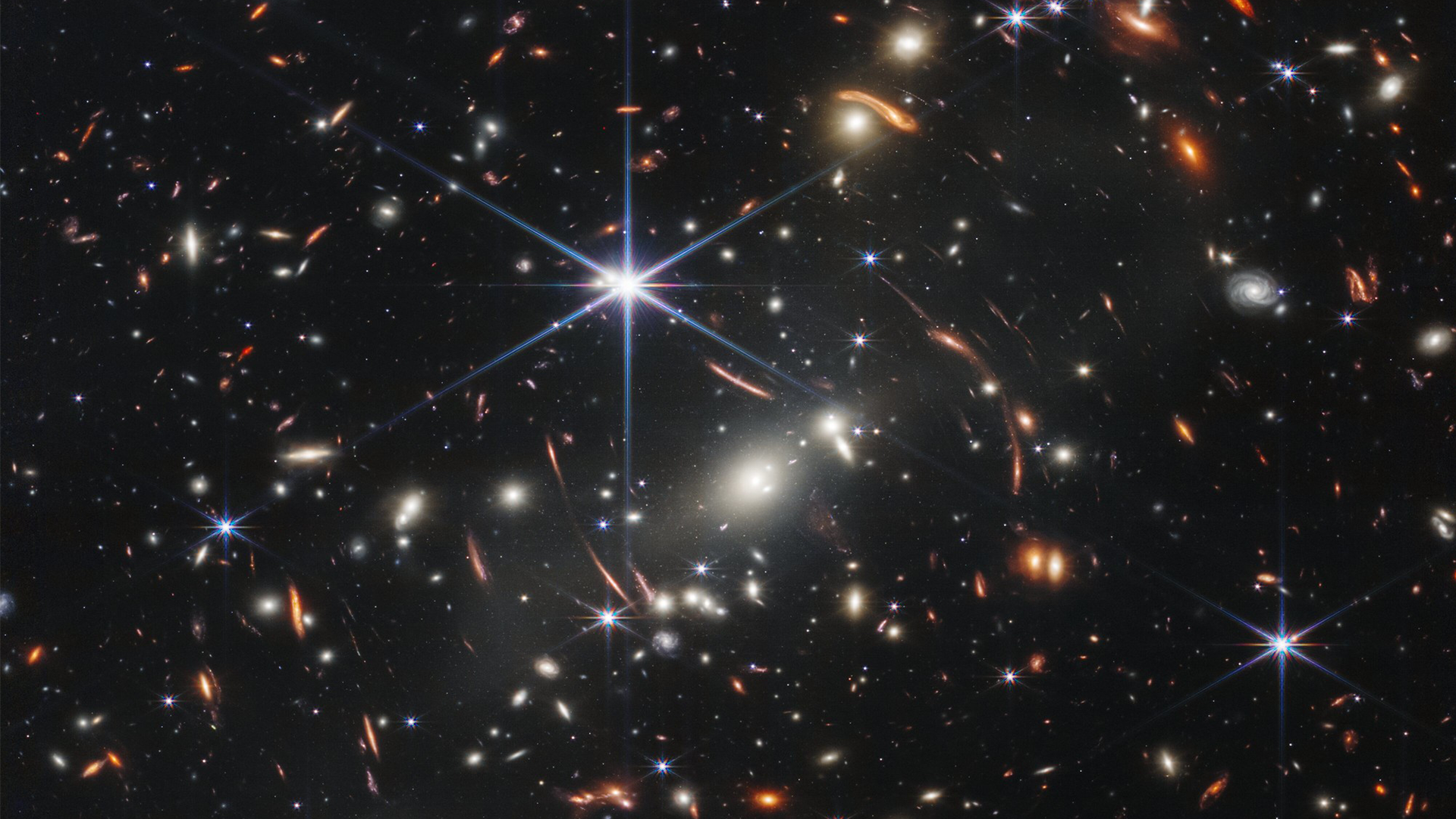First pictures from the A$14 billion James Webb Space Telescope

The first image from the James Webb Space Telescope, released on 12 July 2022.
In summary
- NASA, the European Space Agency (ESA), and the Canadian Space Agency (CSA) have jointly released the first image from the A$14 billion James Webb Space Telescope
- The full-colour images and spectroscopic data are being used by two Australian researchers who’ve been granted precious time in the first observation cycle
- Distinguished Professor Karl Glazebrook and Associate Professor Ivo Labbe are leading projects that use the telescope to uncover the Universe’s first stars, galaxies, baby planets, black holes and more
NASA has released the long-awaited first picture from the $US10 billion James Webb Space Telescope (JWST), with more to come. It’s the moment two Swinburne researchers, Distinguished Professor Karl Glazebrook and Associate Professor Ivo Labbe, have been so excited for.
The Swinburne research teams don’t know what they’ll find, but they are preparing for a new epoch of major discoveries.
The first stars, the first galaxies, baby planets, black holes changing galaxies and much more… these discoveries could solve today’s mysteries – and also create new ones.
Professor Karl Glazebrook, ARC Laureate Fellow and Distinguished Professor at the Centre for Astrophysics and Supercomputing, and Associate Professor Ivo Labbe, Senior Research Fellow at the Centre for Astrophysics and Supercomputing, are both leading projects utilising the telescope’s game-changing infrared capabilities. They are among the first researchers in the world to be granted time in the first observation cycle.
The full-colour images and spectroscopic data are the first to come from the telescope.
Exploring the Universe with the world’s most expensive telescope
The James Webb Space Telescope has been 30 years in the making and delayed by a whole decade. It is a joint initiative of the National Aeronautics and Space Administration (NASA) in the US, the European Space Agency (ESA) and the Canadian Space Agency (CSA).
The result is an engineering feat of a 6.5 metre gold coated mirror made of 18 hexagonal segments, each aligned to 25 millionths of a millimetre.
“It’s the largest telescope ever put into space, with a gold-coated mirror 6.5m in diameter (compared with Hubble’s 2.4m mirror). With size comes complexity, as the entire structure needed to be folded to fit inside the nose cone of an Ariane rocket,” says Distinguished Professor Glazebrook.
“Webb’s primary mission will be to witness the birth of the first stars and galaxies in the early Universe. As the light from these very faint galaxies travels across the vast gulf of space, and 13.8 billion years of time, it gets stretched by the overall expansion of the Universe in a process we call ‘cosmological redshift.’
“This stretching means what started out as extremely energetic ultraviolet radiation from young, hot and massive stars will be received by Webb as infrared light. This is why its mirrors are coated in gold: compared with silver or aluminium, gold is a better reflector of infrared light and red light.”
Why did it take nearly 30 years and roughly A$14 billion?
So, why build it? The James Webb Space Telescope will give us a new view of the Universe, its history and hopefully, its future.
“It will see much farther into the infrared than Hubble could. It’s also up to a million times more sensitive than ground-based telescopes, where the light from distant galaxies is drowned out by the infrared emission of Earth’s own hot atmosphere,” says Swinburne’s Distinguished Professor Glazebrook.
“Because of these previous technological limitations, the first billion years of cosmic history has barely been explored. We don’t know when or how the first stars formed. This is a complex question as stars produce heavy elements when they die. These elements pollute the interstellar gas in galaxies and change how this gas behaves and collapses to form later generations of stars.”
-
Media Enquiries
Related articles
-

- Technology
New research finds Instagram promotes white appearances, cultural appropriation and plastic surgery via filters
New research finds Instagram filters promote white beauty standards, selective cultural appropriation and allow users to ‘try on’ risky surgical procedures.
Thursday 24 July 2025 -

- Technology
- Science
- University
- Engineering
Swinburne to advance battery life and EV cybersecurity with Australian Research Council grants
Swinburne has secured two grants from Australian Research Councils to advance research in energy storage and cybersecurity.
Wednesday 02 July 2025 -

- Technology
- Science
- University
- Sustainability
Swinburne powers breakthroughs in sustainable mining and materials technology
Swinburne innovators have been awarded $4 million in funding from the Australian Government, driving Australia’s future in sustainable innovation through two groundbreaking projects.
Tuesday 15 July 2025 -

- Technology
Microsoft, IBM and Google are racing to develop the first useful quantum computer. Ultracold neutral atoms could be the key.
Swinburne University of Technology has been exploring ultracold neutral atoms for two decades.
Monday 30 June 2025 -

- Technology
Swinburne to harness artificial intelligence to tackle discrimination in sport with adidas Foundation grant
Swinburne is developing an advanced artificial intelligence system to help sporting clubs around Australia tackle discrimination and create more inclusive sporting environments.
Monday 26 May 2025

